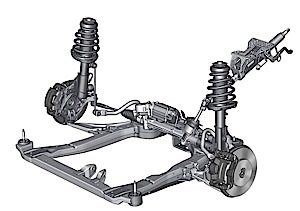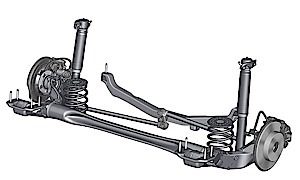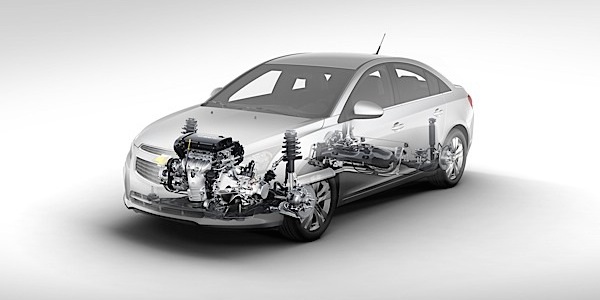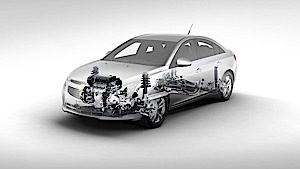The Chevy Cruze debuted as the replacement for the Cobalt. On the outside and under the hood, the Cruze is a big upgrade from the Cobalt. Underneath, however, the two cars have similar setups. In the six years the Cruze has been on the road, it has proven to be a reliable vehicle for the most part, but it has had some suspension issues.
Front Suspension
The Cruze uses a strut setup like the Cobalt. The caster is not adjustable. Camber is adjusted by enlarging the lower bolt hole on the strut-to-knuckle mount. The inner hole should not be enlarged beyond that of the outer hole. 
Only four out of the 13 fasteners for the front suspension do not have a torque angle specification. It is critical to look up the specifications if you are replacing a control arm, ball joint or tie-rod end.
Steering System
The Cruze can come with conventional or electric power steering. Both systems use steering angle sensors mounted to the column that should be recalibrated after an alignment. Even if no change was made to the toe, check the data for the sensor.
The external column-mounted steering angle sensor does not require centering very often. Centering of the steering angle sensor might be required if a module, steering angle sensor or column/rack is replaced. On models with electric power steering, the procedure will include steps so the module can relearn the end stops of the steering rack. If the procedure is not carried out, damage to the power steering system can occur.
The steering angle sensor centering procedure can be completed with a scan tool after the alignment angles have been adjusted. No matter what scan tool you use to carry out the procedure, it is critical that the parking brake is set. If the car has an automatic transmission, it must be in park. If these two steps are not followed, the procedure to calibrate the steering angle sensor will not be allowed to start.
Some 2011-’14 Chevrolet Cruze models equipped with electronic power steering (RPO code NJ0/NJ1) may have increased friction in the steering system. This could cause the steering wheel to stick in the straight-ahead position after driving long distances on a straight highway. The steering wheel can be turned, but it may require increased effort.
GM had two fixes for the problem. On 2011-’12 models, the solution was to replace the steering rack under warranty if the customer was experiencing the problem, according to campaign 14232A. Also, GM released new software to improve steering performance on 2013-’14 models.
Rear Suspension
The Cruze uses a semi-independent twist-beam rear suspension axle like on the Cobalt. The axle assembly attaches to the underbody through a rubber bushing and bracket located at the front of each integral trailing arm. The brackets are bolted to the underbody side rails. The axle structure itself maintains the geometrical relationship of the wheels relative to the centerline of the body.

What is new on the Cruz is a Watt’s linkage. The Watt’s linkage is used in the rear axle of the suspension for performance improvement. This method is intended to prevent relative sideways motion between the axle and body of the vehicle. Watt’s linkage approximates a vertical straight-line motion more closely and does so while locating the center of the axle rather than toward one side of the vehicle, as more commonly used when fitting a long Panhard rod.
It consists of two horizontal equalizer beam links of equal length mounted at each side of the chassis. In-between these two links, a short center link is connected. The center of this center link — the point that is constrained in a straight-line motion — is mounted to the center of the equalizer beam support. All pivoting points are free to rotate in a vertical plane. Watt’s linkage can also be used to prevent axle movement in the longitudinal direction of the vehicle.
Unlike the Cobalt, the rear suspension on the Cruze is not adjustable with shims. The position of the ABS sensor on the rear hub prevents the use of a shim. Installing a shim would pull the sensor away from the rotating hub ring and cause an ABS fault. If the rear angles are out of tolerances, the rear axle has to be replaced.
Recalls and TSBs
The Cruze has been the victim of several high-profile recalls. Almost all of the steering column problems have been resolved in the field or on dealers’ lots.
One problem specific to the Cruze has been noise generated by dry contact between the upper strut mount and the spring insulator.
On these vehicles, contact between the strut’s top mount and the splash shield may cause a squeak during normal steering maneuvers at temperatures less than approximately 35°F (2°C).
Raise and support the vehicle until the tires are a few feet off the ground. Rotate the steering wheel to the right until it reaches full lock. When lubricating the strut, try to lubricate as much of the strut circumference as possible. On the left and right front strut, lubricate the rubber washer and top mount using aerosol heavy-duty silicone lubricant. Using the red straw provided, generously spray the lubricant between the top mount and the rubber splash shield.















